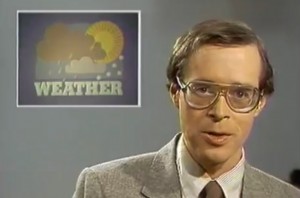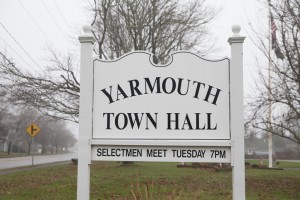
Left to right: WQRC Sports Director, Jon Wetterlow, WQRC News Director, Bob Seay, Dave Read, Legendary weatherman, Don Kent
Though its run may have been brief, for those old enough to remember it WCVX, also known as Channel 58, left an indelible mark on Cape Cod. For those not old enough to remember, or who might need a refresher, WCVX was Cape Cod’s very own high-power television station complete with original programming. Its time on-air was less than a decade, however it created memories and became the launching point for several news personalities still visible today. This is the story of the Cape’s television outlet.
The station which would become WCVX began as a low-power television station run out of Vineyard Haven. On Monday January 16, 1984 the station, with the call letters W58AO, launched as a 12,000-watt outlet. At the time it was the only low-power station to actually go on the air. That night’s ‘Cape News 58’ was anchored by Francis Broadhurst and Mike Gwynn. It was owned by radio station WQRC and its head Don Moore who had been working toward getting a low-power Cape television station on the air for several years.
When the time came the following year to increase Channel 58 to full-power Moore was forced to sell WQRC due to FCC regulations stating individuals could not own television and radio stations in the same market. Station W58AO would go dark for one week as it changed from a 12,000-watt low-power station to a 1.2 million-watt station with signal strength roughly equal to Boston stations WLVI TV-56 and WSBK TV-38.
On July 19, 1985 the new high-power WCVX debuted. Its signal would remain assigned to Vineyard Haven although the main operations would take place in Hyannis. Though it would include reruns of classic television shows like Mary Tyler Moore, The Fugitive, Bob Newhart Show, classic movies, and half-hour blocks of CNN news WCVX would also produce twenty-eight hours of original programming weekly as well. The air waves would be home to shows like Senior Forum hosted by Dr. James Pease, a business show called Common Cents, Cape 11 Alive News, Good Morning Cape Cod (which was broadcast live from the Cape Cod Mall every Wednesday), not to mention local Cape Cod Baseball League games. Some of the names which would become synonymous with TV-58 at the time included Dave Read, Mark Mumford, Will Crocker, Doug Meehan, Bob Halloran, and the ‘Voice of Cape Cod’ Ed Semprini.
Dave Read, a legend of Cape Cod radio for decades, had a brief run with WCVX which he still fondly remembers.

Dave Read reporting on Weather for WCVX TV58
“Having a Cape Cod television station was very exciting,” Read recalls. “I had been doing the weather at the radio station for a long time and it was a natural fit to go over there. It was very part-time, I was doing the evening weather.” However Read was forced to choose between the mediums of television and radio and he chose to remain on the radio. “I was on long enough to get recognized in Stop & Shop,” Read jokes.
When asked what was the biggest story he personally covered during his run on WCVX Read responded “Hurricane Gloria.” That storm struck the Cape in late-September of 1985 with peak winds of 145mph and the top Cape Cod wind gust of 110mph being recorded in Chatham.
Bob Halloran, who works today at WCVB Channel 5 in Boston as a news and sports anchor, began his career at WCVX as a cameraman.
“They were doing a half-hour newscast Monday through Friday, and Michelle Haynes had a talk show for which I ran studio camera,” Halloran recalls. “I eventually became a news reporter, news anchor and News Director, but I always wanted to be in sports. When Michael Gwynn left to work at Channel 12 in Providence, I took his place at the sports desk at TV-58.”
The biggest moment Halloran covered? “President George H.W. Bush came to the Cape in 1990. We covered him landing, I believe, at Otis Air National Guard Base. I was anchoring the news and just talked over the video from the anchor desk.”
TV-58’s debut was not without its difficulties. In a sad bit of irony on the very same day the new WCVX went on the air the Federal Communications Commission would abolish the ‘must-carry’ rule. This had made it mandatory for cable companies to carry all stations within a thirty-five mile radius of a cable facility. After the rule was struck down the fledgling WCVX would only be available in 40% of Cape Cod homes with Cape Cod Cablevision initially refusing to carry it. TV-58 would not achieve total Cape coverage until August 10, 1987 when Campbell Cable, which served Bourne and Sandwich added the station.
Despite gaining full coverage WCVX was in financial peril. Moore had spent a considerable amount of his own money keeping the station afloat and when he was unable to find other potential investors the writing was on the wall. Both Halloran and Read agree that Don Moore did all he could to keep WCVX viable, however in October 1987 he sold the station to Sentry Federal Savings Bank. Sentry took three months before choosing Dan Carney as the new head of the station. Viewership would increase with TV-58’s prime time outdrawing any local radio station. According to surveys at the time sixty percent of Cape residents said they tuned in to WCVX at least once in a while. The desire for more localized coverage led people to tune in, however although the extent of the local reporting was tremendous the station’s future came down to money.
By 1990 the writing was on the wall. WCVX would let ten employees go in cost cutting measures dropping the total number of employees from forty-five in 1988 to only eight. The last gasp of TV-58 came on July 2, 1991 with a showing of the 1955 film Kentucky Rifle. It would go dark after and remain dark for three years. It was then that the station was bought by Boston University to be rechristened WZBU, a satellite affiliate of BU’s WABU station. In 1999 it would be bought by PAX TV, which later became Ion TV.
Although it officially went off the air nearly thirty years ago WCVX has left a lasting legacy. Many of its former employees went on to bigger and better things. Bob Halloran has nothing but high praise for the station and its former employees.
“There were an awful lot of very good, hard-working talented people who worked there,” Halloran says. “We had a live truck and up to date editing and video equipment. Nothing rinky-dink about it. It was a legit television station cranking out a lot of news with a small staff. I think the Cape lost something special that day.”
By Christopher Setterlund























